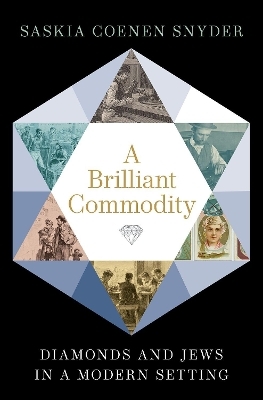
A Brilliant Commodity
Diamonds and Jews in a Modern Setting
Seiten
2023
Oxford University Press Inc (Verlag)
978-0-19-761047-3 (ISBN)
Oxford University Press Inc (Verlag)
978-0-19-761047-3 (ISBN)
The first history of Jews in the nineteenth-century transatlantic diamond industry, A Brilliant Commodity shows how Jews became key players in the trade from its earliest days-from South Africa to Amsterdam and London to New York-to its place as a lucrative commodity in the global economy.
Following diamonds from African mines to the necklines of high society women, this international history shows why Jews were central to the transatlantic gem trade and its growth into a global industry.
During the late nineteenth century, tens of thousands of diggers, prospectors, merchants, and dealers extracted and shipped over 50 million carats of diamonds from South Africa to London. The primary supplier to the world, South Africa's diamond fields became one of the formative sites of modern capitalist production. At each stage of the diamond's route through the British empire and beyond-from Cape Town to London, from Amsterdam to New York City-carbon gems were primarily mined, processed, appraised, and sold by Jews.
In A Brilliant Commodity, historian Saskia Coenen Snyder traces how once-peripheral Jewish populations became the central architects of a new, global exchange of diamonds that connected African sites of supply, European manufacturing centers, American retailers, and western consumers. Centuries of restrictions had limited Jews to trade and finance, businesses that often heavily relied on internal networks. Jews were well-positioned to become key players in the earliest stage of the diamond trade and its growth into a global industry, a development fueled by technological advancements, a dramatic rise in the demand of luxury goods, and an abundance of rough stones. Relying on mercantile and familial ties across continents, Jews created a highly successful commodity chain that included buyers, brokers, cutters, factory owners, financiers, and retailers.
Working within a diasporic ethnic community that bridged city and countryside, metropole and colony, Jews helped build a flourishing diamond industry, notably Hatton Garden in London and the Diamond District of New York City, and a place for themselves in the modern world.
Following diamonds from African mines to the necklines of high society women, this international history shows why Jews were central to the transatlantic gem trade and its growth into a global industry.
During the late nineteenth century, tens of thousands of diggers, prospectors, merchants, and dealers extracted and shipped over 50 million carats of diamonds from South Africa to London. The primary supplier to the world, South Africa's diamond fields became one of the formative sites of modern capitalist production. At each stage of the diamond's route through the British empire and beyond-from Cape Town to London, from Amsterdam to New York City-carbon gems were primarily mined, processed, appraised, and sold by Jews.
In A Brilliant Commodity, historian Saskia Coenen Snyder traces how once-peripheral Jewish populations became the central architects of a new, global exchange of diamonds that connected African sites of supply, European manufacturing centers, American retailers, and western consumers. Centuries of restrictions had limited Jews to trade and finance, businesses that often heavily relied on internal networks. Jews were well-positioned to become key players in the earliest stage of the diamond trade and its growth into a global industry, a development fueled by technological advancements, a dramatic rise in the demand of luxury goods, and an abundance of rough stones. Relying on mercantile and familial ties across continents, Jews created a highly successful commodity chain that included buyers, brokers, cutters, factory owners, financiers, and retailers.
Working within a diasporic ethnic community that bridged city and countryside, metropole and colony, Jews helped build a flourishing diamond industry, notably Hatton Garden in London and the Diamond District of New York City, and a place for themselves in the modern world.
Saskia Coenen Snyder is Associate Professor of Modern Jewish History at the University of South Carolina. She is the author of Building a Public Judaism: Synagogues and Jewish Identity in Nineteenth-Century Europe, which was a finalist for the Grawemeyer Award in Religion.
Preface
Introduction: Clarity, Cut, Carat, and Color
Chapter 1: "Like Dewdrops in the Waving Grass": Diamonds in South Africa
Chapter 2: An Empire Made Portable: London
Chapter 3: "As Long As It Sparkles!": Amsterdam
Chapter 4: "Luxuries Have Now Become Necessities": New York
Chapter 5: Jews and Diamonds in the Public Imagination
Conclusion
Acknowledgments
Notes
Bibliography
Index
| Erscheinungsdatum | 03.10.2022 |
|---|---|
| Zusatzinfo | 50 black and white images |
| Verlagsort | New York |
| Sprache | englisch |
| Maße | 238 x 164 mm |
| Gewicht | 585 g |
| Themenwelt | Geisteswissenschaften ► Geschichte ► Regional- / Ländergeschichte |
| Geschichte ► Teilgebiete der Geschichte ► Wirtschaftsgeschichte | |
| Geisteswissenschaften ► Religion / Theologie ► Judentum | |
| ISBN-10 | 0-19-761047-1 / 0197610471 |
| ISBN-13 | 978-0-19-761047-3 / 9780197610473 |
| Zustand | Neuware |
| Haben Sie eine Frage zum Produkt? |
Mehr entdecken
aus dem Bereich
aus dem Bereich


